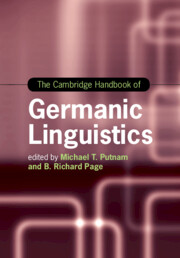Book contents
- The Cambridge Handbook of Germanic Linguistics
- Cambridge Handbooks in Language and Linguistics
- The Cambridge Handbook of Germanic Linguistics
- Copyright page
- Contents
- Figures
- Maps
- Tables
- Contributors
- Acknowledgments
- Germanic Languages
- Part I Phonology
- Part II Morphology and Agreement Systems
- Part III Syntax
- Part IV Semantics and Pragmatics
- Part V Language Contact and Nonstandard Varieties
- Chapter 29 Second Language Acquisition of Germanic Languages
- Chapter 30 Urban Speech Styles of Germanic Languages
- Chapter 31 The West Germanic Dialect Continuum
- Chapter 32 The North Germanic Dialect Continuum
- Chapter 33 Heritage Germanic Languages in North America
- Chapter 34 Minority Germanic Languages
- Chapter 35 Germanic Contact Languages
- Index
- References
Chapter 29 - Second Language Acquisition of Germanic Languages
from Part V - Language Contact and Nonstandard Varieties
Published online by Cambridge University Press: 31 March 2020
- The Cambridge Handbook of Germanic Linguistics
- Cambridge Handbooks in Language and Linguistics
- The Cambridge Handbook of Germanic Linguistics
- Copyright page
- Contents
- Figures
- Maps
- Tables
- Contributors
- Acknowledgments
- Germanic Languages
- Part I Phonology
- Part II Morphology and Agreement Systems
- Part III Syntax
- Part IV Semantics and Pragmatics
- Part V Language Contact and Nonstandard Varieties
- Chapter 29 Second Language Acquisition of Germanic Languages
- Chapter 30 Urban Speech Styles of Germanic Languages
- Chapter 31 The West Germanic Dialect Continuum
- Chapter 32 The North Germanic Dialect Continuum
- Chapter 33 Heritage Germanic Languages in North America
- Chapter 34 Minority Germanic Languages
- Chapter 35 Germanic Contact Languages
- Index
- References
Summary
Second language acquisition research focuses on how people acquire and use a second language (L2), and the underlying mechanisms that support these processes. Key issues include the nature of learners’ L2 linguistic representations, how such representations develop from the L2 input learners receive, and the ways in which features from learners’ two languages interact to influence L2 acquisition and use. These issues address larger debates concerning the extent to which L2 learners <spaced en> and especially adult learners<spaced en>can acquire nativelike L2 proficiency, and whether L1 and L2 acquisition rely on the same underlying mechanisms, or whether fundamentally different mechanisms and strategies are involved. For over 40 years, Germanic languages, especially German and Dutch, have played a central role in L2 acquisition research. The present chapter reviews selected findings from this research and discusses how these findings contribute to our understanding of the mechanisms that drive L2 acquisition and use.
Keywords
- Type
- Chapter
- Information
- The Cambridge Handbook of Germanic Linguistics , pp. 689 - 713Publisher: Cambridge University PressPrint publication year: 2020



